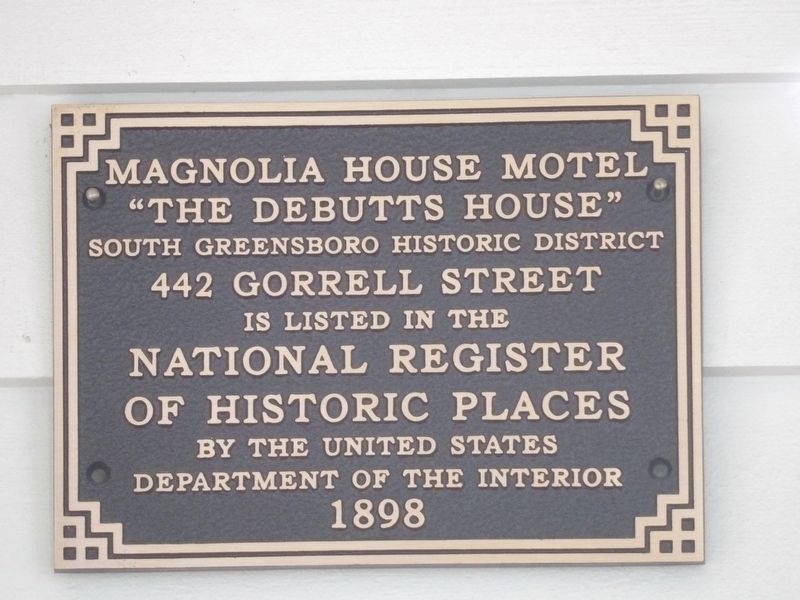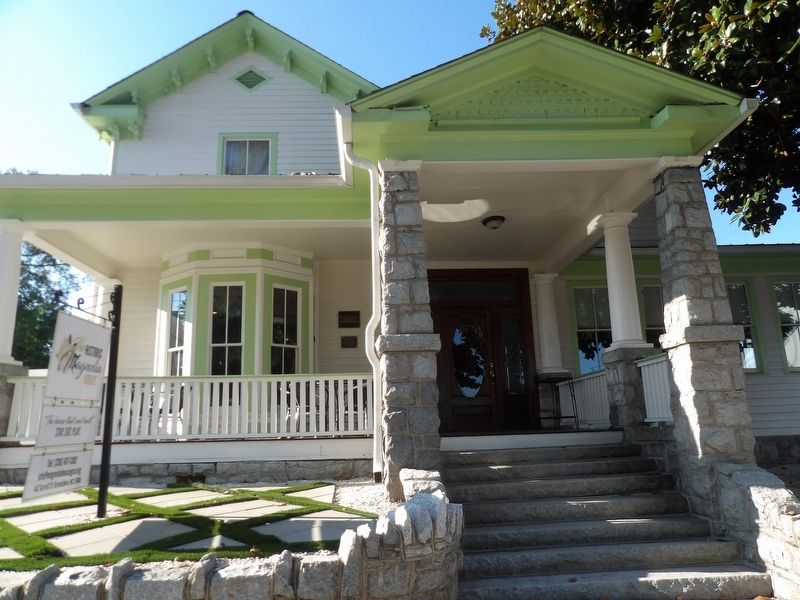Gorrell St. Community in Greensboro in Guilford County, North Carolina — The American South (South Atlantic)
Magnolia House Motel
“The DeButts House”
— South Greensboro Historic District —
is listed in the
National Register
of Historic Places
by the United States
Department of the Interior
1898
Topics and series. This historical marker is listed in these topic lists: African Americans • Architecture • Industry & Commerce. In addition, it is included in the National Register of Historic Places series list. A significant historical year for this entry is 1898.
Location. 36° 3.994′ N, 79° 47.016′ W. Marker is in Greensboro, North Carolina, in Guilford County. It is in Gorrell St. Community. Marker is at the intersection of Gorrell Street and Plott Street, on the right when traveling east on Gorrell Street. Touch for map. Marker is at or near this postal address: 442 Gorrell St, Greensboro NC 27406, United States of America. Touch for directions.
Other nearby markers. At least 8 other markers are within walking distance of this marker. Dr. Martin Luther King, Jr. (approx. ¼ mile away); Albion W. Tourgée (approx. ¼ mile away); Piedmont Railroad (approx. 0.3 miles away); Confederate Cabinet (approx. 0.4 miles away); North Carolina Railroad (approx. 0.4 miles away); Jefferson Davis (approx. 0.4 miles away); Cigar Industry (approx. 0.4 miles away); William McBryar (approx. 0.4 miles away). Touch for a list and map of all markers in Greensboro.
Regarding Magnolia House Motel. Excerpt from the National Register nomination for the South Greensboro Historic Distric, which includes this property:
The South Greensboro Historic District is significant as one of Greensboro's earliest and most intact late nineteenth- and early twentieth-century neighborhoods. Its houses, set on small city lots, display a variety of styles and forms popular elsewhere in the city and across the state. Of particular note are its Italianate and Queen Anne style dwellings, both small and large, and its bungalows. The development of the district as a neighborhood, rather than just a disconnected collection of houses fronting the main thoroughfare south out of town, began about 1880 and continued until 1941, by which time houses stood upon virtually every lot. The district's growth during these years, which bracket its period of significance, reflects a number of trends central to the city's growth during the same period, including the development of a road, trolley, and railroad network; the emergence of downtown as a busy commercial center; and the establishment of the city's industries along railroad lines. The district's confinement within a relatively restricted area also reflects racial housing patterns throughout the city.
The original or an early resident of the Italianate/Queen Anne house was Daniel D. DeButts, a traveling salesman.
Also see . . .
1. South Greensboro Historic District (PDF). National Register nomination submitted for the district, which was listed in 1991. (Prepared by Marvin A. Brown, Greensboro Preservation Society (1991); via National Archives) (Submitted on October 16, 2023, by Duane and Tracy Marsteller of Murfreesboro, Tennessee.)
2. Historic Magnolia House History. The Historic Magnolia House in Greensboro was a popular destination for African American travelers who were not allowed to share the same accommodations as Caucasians, including the same eating and drinking facilities, during segregation in America in the mid-twentieth century. (Historic Magnolia House) (Submitted on October 16, 2023, by Duane and Tracy Marsteller of Murfreesboro, Tennessee.)
Credits. This page was last revised on October 16, 2023. It was originally submitted on October 6, 2023, by Duane and Tracy Marsteller of Murfreesboro, Tennessee. This page has been viewed 51 times since then and 11 times this year. Photos: 1, 2. submitted on October 6, 2023, by Duane and Tracy Marsteller of Murfreesboro, Tennessee.

